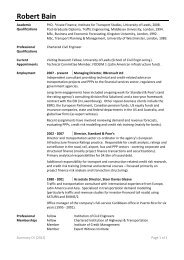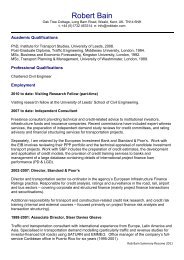Disincentivising overbidding for toll road concessions
Disincentivising overbidding for toll road concessions
Disincentivising overbidding for toll road concessions
- No tags were found...
Create successful ePaper yourself
Turn your PDF publications into a flip-book with our unique Google optimized e-Paper software.
3 │ TOLL ROAD CASE STUDIES<br />
31<br />
Toll <strong>road</strong> case studies<br />
This section presents a selection of case studies and related material to illustrate different approaches being taken<br />
to <strong>toll</strong> <strong>road</strong> <strong>concessions</strong> around the world. Most of these approaches focus on traffic risk and its allocation, many<br />
respond to concerns about the predictability of demand (and revenue), and a number specifically address observed<br />
patterns of <strong>overbidding</strong> to secure contract award. The different approaches commonly build on local experience.<br />
Lessons from earlier <strong>concessions</strong>, combined with clearer policy objectives and a more sophisticated institutional<br />
understanding of likely bidder behaviour, are employed to reshape or fine-tune projects, the associated procurement<br />
processes and, critically, the incentivising mechanisms embedded in concessionaire compensation regimes.<br />
In terms of state-of-the-practice, the case studies presented here are not exhaustive; rather, they provide some<br />
illustrative, real-world examples of the different rules applied by public sector concession grantors when seeking to<br />
engage with their private sector counterparts. The analysis focuses on five models:<br />
••<br />
availability-based payment mechanisms;<br />
••<br />
‘pass-through’ <strong>toll</strong>s;<br />
••<br />
flexible-term <strong>concessions</strong>;<br />
••<br />
construct then concession;<br />
••<br />
bundle new construction with an existing asset.<br />
Each of these models is considered in turn, following a high-level, introductory discussion of traffic risk allocation.<br />
Traffic risk allocation<br />
Any consideration of mechanisms that could be employed to disincentivise bidders from <strong>overbidding</strong> <strong>for</strong> <strong>toll</strong> <strong>road</strong><br />
<strong>concessions</strong>—specifically through the submission of optimistic projections of asset usage (and revenue generation)—<br />
should start by examining traffic risk and its allocation. In this context a spectrum can be considered, with full<br />
risk transfer to the private sector concessionaire at one end and full retention of traffic risk by the public sector<br />
concession grantor at the other. Both approaches are being employed in Australia, as they have been in many other<br />
countries.<br />
The traditional <strong>toll</strong> <strong>road</strong> concession model involves full traffic risk transfer to the private sector. This has been the<br />
dominant model used in Australia and worldwide (Vassallo, 2006). 78 The purest <strong>for</strong>m is the stand-alone (self-funding)<br />
fixed-term concession under which the private sector bids on the basis that it will retain all <strong>toll</strong> receipts; and that<br />
these receipts will be sufficient in aggregate to cover all operating and debt-servicing costs, and allow <strong>for</strong> a return on<br />
capital. It is a stand-alone, self-supporting solution insofar as the commercial viability of concession rests entirely<br />
on the quantum of user charges generated over its term, with no financial input from (or abstraction by) the public<br />
sector grantor. There is a simple, direct link between what and how users are charged and the income received by<br />
78 Vassallo, J.M. (2006), ‘Traffic Risk Mitigation in Highway Concession Projects: The Experience of Chile’, Journal of Transport Economics and<br />
Policy, 40:3, 359–81.<br />
29






